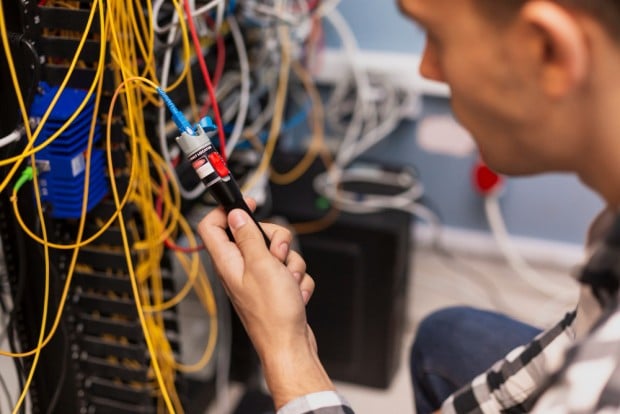Leased line vs fibre broadband – both these technologies are reliable and fast. However, there are some major differences between the two.
This article will discuss those differences and help you determine which option is the best for your business.
To start with, fibre broadband can mean 2 things – Fibre to the Premises (FTTP) and Fibre to the Cabinet (FTTC). Let’s throw the light on both.
Leased line vs Fibre to the Premises (FTTP)

A leased line is a dedicated and uncontended internet line which is rented by a business from an Internet service provider (ISP). The line is exclusively laid from the premises of the ISP to the business.
In comparison, FTTP is a contended broadband connection that uses fibre optic cables to send internet signals from a broadband exchange to the business premises.
Quick question: Many people inquire about the difference between full fibre and FTTP. Well, they are different names for the same technology.
Now, let’s discuss the differences.
- Leased lines offer symmetrical bandwidth which ranges from 10Mbps to as high as 10Gbps. FTTP offers asymmetrical bandwidth at speeds up to 1Gbps only. There are some broadband providers in the UK that provide better speeds than this, but that is not common.
- Leased lines provide a private and exclusive connection, ensuring a 1:1 contention ratio. This means the bandwidth is not shared with any other users which guarantees consistent and reliable speed at all times. FTTP, on the other hand, typically has a high contention ratio. The line is shared among multiple users in the same area which leads to fluctuations in speed, especially during peak usage times.
- Leased lines are always more expensive than FTTP due to the dedicated and reliable internet connection they provide. The price of a 100Mbps leased line in the UK typically ranges from £185 – £270 per month. FFTP, conversely, provides the same bandwidth at £30 – £60 but bear in mind that the speed will be asymmetrical and prone to fluctuations (although not as much as copper lines).
- Leased lines are renowned for their exceptional reliability. They offer consistent performance and minimal downtime, thanks to the service level agreements (SLAs) and dedicated nature of the line.
FTTP connections can experience variability in speed and potential service interruptions partly because they lack robust SLAs and partly because they’re shared.
- The installation of leased lines involves trenching and groundwork to lay the fibre optic line from the ISP to your business site. This increases the cost (£2000 – £10000 generally) and the time (typically 45-85 days) of installation. Get detailed information related to costs of leased lines. FTTP installation, on the other hand, is quicker and less costly because it employs the existing infrastructure of broadband exchanges. The provider just has to lay the line to the new site from there.
Compare Leased Line Quotes Today
Leased line vs Fibre to the Cabinet (FTTC)
Fibre to the Cabinet (FTTC) is the technology where fibre optic runs to a street cabinet near your site, and the remaining connection to the premises uses traditional copper wires. Although it is faster than ADSL but will always be slower than FTTP.Let’s look at the differences between a leased line and FTTC. Many differences are the same as FTTP so I’ll only discuss the unique ones in the following points.
- As discussed earlier, leased lines provide a high-speed internet connection in the range of 10Mbps – 10Gbps but FTTC can only offer speeds up to 80Mbps in the UK (as per 2024 data).
- A leased line will always be more expensive than an FTTC line. Businesses should expect to pay £185 – £270 per month for a 100Mbps leased line while the corresponding FTTC broadband line will only be available at £20 – £40 per month. This high cost reflects the superior reliability and service levels of leased lines.
- Leased lines are full fibre connections, meaning they use fibre optic cables end-to-end, from the ISP directly to the premises. FTTC, however, involves fibre optic cables running to the street cabinet with the final connection to the premises made via copper wires.
Which one is better for my business?

Now comes the big question – whether leased lines are better for my business or FTTP and FTTC. Ask these simple questions to arrive at the conclusion.
- What are my bandwidth needs?
Leased line provides scalable speeds up to 10Gbsp. FTTP to 1 Gbps and FTTC to 80Mbps.
- How reliable do I want my internet connection to be?
Leased lines are the most reliable, with downtime as low as 9 seconds per day if you opt for a 99.99% SLA. FTTP follows in reliability, with FTTC being the least reliable of the three. For FTTP and FTTC, you are generally responsible for reporting issues to the provider, as they typically do not have regular monitoring for problems.
- What is my budget?
Leased lines are the most expensive followed by FTTP and FTTC. Find the balance of reliability and cost when making this comparison e.g. a leased line is very expensive but comes with ultra-high reliability. If your business can afford some interruptions and downtime, FTTP could be a great option.
- How scalable do I want the line to be?
Leased lines offer high scalability, as long as they are supported by a high-speed bearer that can handle the maximum bandwidth. FTTP is also suitable for businesses with increasing bandwidth needs, though it may not scale as extensively as leased lines.
FTTC is the least scalable because the maximum speed it can offer is low (80Mbps in the UK, generally, as per 2024 data)
Switch To Leased Lines In The UK With ComparedBusiness
ComparedBusiness can help you link with the top leased line providers in the UK. Just submit your requirements in less than 2-mins and we will match you with the top service providers in the UK. You can pick and choose the best option as per your business requirements. This service comes to you at no cost.
FAQs
When we compare the speed of both options, the leased line is evidently faster than FTTC. let’s look at their speeds once again to get a better idea. The leased line offers a speed range from 10mbps to as high as 10gbs. However, the highest speed FTTC can provide goes up to 80mbps.
If your business has an increasing need for higher bandwidth then you can consider choosing a leased line for your internet connection. With this option, you get a wide range of bandwidth that you can scale according to needs along with more security and fewer disruptions. On the other side, if your business has a moderate need for internet bandwidth, FTTP is for you. Lastly, if you are just starting out and want a connection with minimal data needs then you can go for FTTC which is best suited for small businesses.
If your business performs operations with a minimum need for internet bandwidth, like emailing, setting up occasional calls, web surfing, etc then you can go for the affordable option of FTTP which will cost you around £30–£60 per month. In comparison leased lines can cost 6 times more than FTTP due to the nature of the connection providing higher bandwidth and minimal disruptions.
